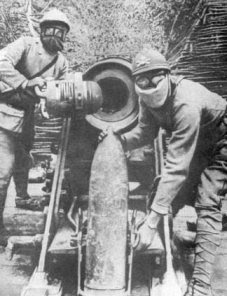Chapter 5: Don't Want Dye? OK, How About Poison Gas?
"You will make war when it suits us and keep peace when it doesn't And in return you shall have the support of my newspapers, and the delight of imagining that you are a great statesman." -Undershaft, the armament maker, in Bernard Shaw's "Major Barbara," Act III, 1905
It was Carl Duisberg, head of I.G., a man who "would not tolerate dissent," a man who "believed in the 'Fuhrer Principle' long before Hitler was ever heard of," it was Duesberg who urged the employment of chemical warfare in the autumn of 1914. (18) Duesberg ... "saw immediately that poison gas warfare could revive the moribund dyestuff industry, which was almost at a standstill since the beginning of the war he not only devoted Bayer to the poison gas project but also involved himself personally in the experiments." (19)
On April 22, 1915, when the Germans finally tried out their new weapon - chlorine gas - it was the I.G. companies and I.G. chemists that supplied it. Five thousand died terrible deaths - another 10,000 were wounded. (20) By the end of the war, at least 91 thousand men had died of gas. Another 1.3 million had been wounded by gas.... one of them being a young soldier named Adolph Hitler (21).
(18) Harris, Robert and Paxman, Jeremy, "A Higher Form of Killing - The Secret Story of Gas and Germ Warfare," 1983, Triad, p. 9
(19) "The Crime and Punishment of IG Farben," p. 21
(20) ibid, pp. 22-23. See also "A Higher Form of Killing," pp. 2-3, 10
(21) "A Higher Form of Killing," p. 32








No comments:
Post a Comment